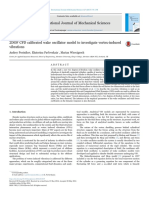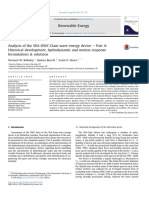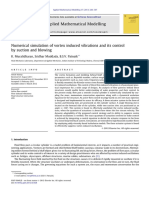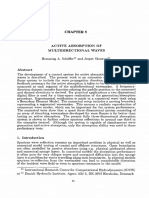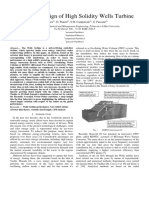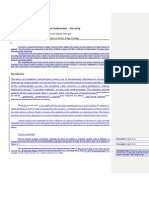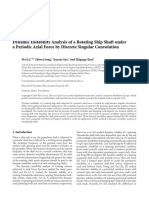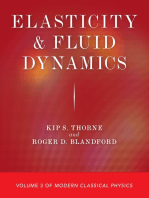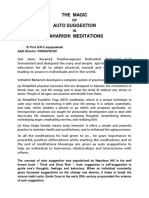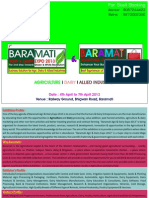Nishi 2009
Nishi 2009
Uploaded by
phandvCopyright:
Available Formats
Nishi 2009
Nishi 2009
Uploaded by
phandvCopyright
Available Formats
Share this document
Did you find this document useful?
Is this content inappropriate?
Copyright:
Available Formats
Nishi 2009
Nishi 2009
Uploaded by
phandvCopyright:
Available Formats
ORI GI NAL ARTI CLE
Quasisteady theory for the hydrodynamic forces on a circular
cylinder undergoing vortex-induced vibration
Yoshiki Nishi Kentaroh Kokubun
Kunihiro Hoshino Shotaro Uto
Received: 13 June 2008 / Accepted: 28 October 2008 / Published online: 5 December 2008
JASNAOE 2008
Abstract Vortex-induced vibrations of a rigid circular
cylinder were studied by constructing a theory based on a
wake oscillator model under quasisteady approximations,
thereby evaluating vortex-induced hydrodynamic forces
acting on the cylinder. A lock-in limit line representing the
boundary for the occurrence of frequency lock-in was also
theoretically derived. Hydrodynamic forces in forced
oscillation problems estimated by the theory were com-
pared with measured ones. Although some discrepancies
were found, particularly in cases with high-frequency
oscillations, good agreement was achieved in most cases.
Accordingly, we conclude that the present theory captures
well real phenomena in the wake downstream of a cylinder
subjected to a ow.
Keywords Vortex-induced vibration Wake oscillator
model Riser pipe Hydrodynamic force Lock-in
1 Introduction
Recent rising prices for fossil fuels urgently require us to
advance new resource developments not only on land but
also in the seas. In particular, mining of resources from the
seaoor deeper than 2,500 m is attracting a lot of attention
due to the potentially large size of these reserves.
The design and construction of a marine riser pipe is
one of the most important technologies to realize this. It
is well recognized that a marine riser pipe subjected to
ows oscillates under the inuence of vortices generated
and shed downstream of the pipe. These kinds of oscil-
lation are generally called vortex-induced vibrations
(VIVs) [13] and have the characteristic of self-excited
oscillations; thus their amplitude can become remarkably
large even under weak ow conditions. Therefore, the
fatigue accumulated in the pipes structure caused by the
VIV is of particular concern, and has to be accurately
estimated for designing and operating the riser pipe
safely.
The VIV occurs in the framework of a coupled uid-
structure dynamic system. Thus, we have to address con-
currently the structural dynamics of the pipe and the
hydrodynamics of the uids surrounding the pipe. To date,
several researchers have attempted to simulate the pipes
motion in water numerically by using the nite element
method (FEM) [4, 5], mode expansion method [6, 7], and
so on. To develop a practical tool for simulation, the
establishment of a method for estimating hydrodynamic
forces acting on the pipe is of considerable signicance. A
few commercial codes such as SHEAR7 have made a
database composed of experimental data on the forces
measured in tank tests. However, in general, the collection
of data applicable to every condition in actual seas is not
feasible because this requires a large test facility. Alter-
native to database-based methods, computational uid
dynamics (CFD) can compute the forces accurately [8, 9] if
enough computational times and numbers of grids are
easily available. Nonetheless, considering the inefciency
involved in the regridding procedure to handle the complex
shape and motion of a long elastic pipe, this does not seem
to be a hopeful method.
Y. Nishi (&)
Department of Systems Design for Ocean-Space,
Graduate School of Engineering,
Yokohama National University, 79-5 Tokiwadai,
Hodogaya, Yokohama 2408501, Japan
e-mail: ynishi@ynu.ac.jp
K. Kokubun K. Hoshino S. Uto
National Maritime Research Institute,
6-38-1 Shinkawa, Mitaka 1810004, Japan
1 3
J Mar Sci Technol (2009) 14:285295
DOI 10.1007/s00773-008-0036-z
Our strategy is to establish a theory based on modeling
of vortex-induced hydrodynamic forces acting on a cir-
cular cylinder, and to nd analytical solutions of this
theory. This is because such an approach can provide a
substantially practical tool to estimate the forces with
little requirement in terms of computing time and mem-
ory, if its accuracy is sufciently well validated and is
coupled with a method for simulating the elastic motion
of the pipe. Such approaches have scarcely been con-
ducted so far.
Birkhoff [10] has attempted to determine the vortex
shedding frequency of a xed cylinder theoretically by
introducing a model called the wake oscillator. Inspired
by this idea, several previous works have dealt with VIV by
analytical approaches [1114]. However, most of the ana-
lytical procedures employed in these works involve several
parameters determined not analytically but empirically,
without carrying out sensitivity analyses, leading to a lack
of versatility in the theory. In addition, these previous
works have not yet claried whether the external force in
the oscillators equation of motion is proportional to the
displacement, velocity, or acceleration of the cylinders
translation motion.
Accordingly, this paper attempts to construct a theory
for a forced oscillation problem, using laws of dynamics as
much as possible to estimate the hydrodynamic forces
acting on a rigid circular cylinder, to solve it analytically,
and to validate it by conducting experiments.
2 Quasisteady wake oscillator model
Close observation of the wake region has revealed that this
region exhibits swing-like motion and stretching defor-
mation in conjunction with growing and shedding vortices
[15]. The present theory is based on the replacement of the
lift forces acting on the cylinder with those acting on a
rigid bar called the wake oscillator moving rotationally
with the wake region (Fig. 1). We should remark that the
approximation using the rigid bar is the lowest-order
approximation for the wake dynamics. A model with a
higher-order approximation using a exible bar, or several
connected bars, may be necessary to describe adequately
the variation of the vortex shedding modes such as 2S, 2P,
and 2P ? 2S modes [16].
In this study, we will restrict our discussion to transla-
tion motions of one degree of freedom transverse to a
uniform ow. The rotational motion of the wake oscillator
is described using simple rigid-body dynamics and
hydrodynamics. A schematic drawing of the wake oscil-
lator is shown in Fig. 2. In the following subsections, an
equation of motion for the rotating oscillator is built by
modeling each force responsible for the motion of the
oscillator. The denitions of the mathematical notations are
listed in Table 1.
2.1 Inertia and restoring moments
The inertia moment of the oscillator I is
I = m
d
2
l
_ _
2
; (1)
Fig. 1 Schematic illustrations for the generation and shedding of
vortices at the wake region. The motion of virtual wake oscillators is
also depicted
Fig. 2 Denitions of the sizes, displacement, and angle of rotation of
the wake oscillator
286 J Mar Sci Technol (2009) 14:285295
1 3
where m = 2qsl is the mass of the wake oscillator. This
means that the motion of the wake region is modeled by the
mechanical motion of a rigid bar with mass m and radius of
gyration
d
2
l:
The coefcient of the restoring moment k is expressed as
k = 2pqlV
2
d
2
l
_ _
: (2)
This is derived from the lift force acting on a at plate
subjected to a potential ow with a nonzero angle of attack
(see the Appendix for more detail). It should be noted
that the steady state of a body motion is assumed in Eq. 2,
since KuttaJoukowskis theorem valid in the steady state
is used to derive Eq. 2. Strictly speaking, unsteady lift
force should be applied when treating a violently
oscillatory motion such as VIV accompanied with
unsteady body motions. However, we employ Eq. 2 for
the simplicity of mathematical formulations, meaning that
the present approach is a quasisteady theory.
From Eqs. 1 and 2, the eigenfrequency of the oscillator
x
e
satises
x
2
e
=
pV
2
s
d
2
l
_ _ : (3)
This frequency corresponds to the vortex shedding
frequency of a circular cylinder xed in a ow (Strouhal
Table 1 Denitions and values
of the variables and parameters
used in the quasisteady wake
oscillator theory
Symbol Denition Value Unit
d Diameter of a circular cylinder 0.025 m
l
_
d The ratio of the mean half-length of the wake oscillator to d 1.10
s/d The ratio of the width of the wake oscillator to d 1.25
q Density of water 990 kg m
-3
f Coefcient of the slope of the lift force 1.16
V Velocity of a uniform ow ms
-1
t, s Dimensional and nondimensional time s,
a Rotation angle of the wake oscillator rad
a
f
, a
e
Forced and eigencomponent of a rad
a
f
; a
e
Amplitude of the forced and eigencomponent of a in stationary
oscillation states
rad
I Moment of inertia of the wake oscillator kg m
2
m Mass of the wake oscillator kg
k Coefcient of restoring moment acting on the wake oscillator kg m
2
s
-2
b Coefcient of external force term proportional to H
//
p Coefcient of nonlinear damping term rad
-2
x
f
, x
e
Frequency of forced oscillation, and eigenfrequency of the wake oscillator rad s
-1
x, k Frequency of a forced oscillation, and eigenfrequency of the wake oscillator
normalized by x
0
x
0
Characteristic frequency used for the dimensionless notations of frequency rad s
-1
S
f
Reduced frequency of forced oscillations dened as x
f
d=2pV
S
e
Reduced frequency of oscillators eigenoscillations dened as x
e
d=2pV
X Ratio of forced frequency to wake oscillators eigenfrequency
l
0
Amplitude of the variations in the longitudinal length of the wake oscillator m
c Self-excitation coefcient
M
s
The moment of the lift force induced by shed vortex kg m s
-2
C
s
The circulation of the shed vortex m
2
s
-1
C
L
Lift force coefcient
h;
h Displacement and amplitude of forced oscillation m
H;
H Displacement and amplitude of forced oscillation normalized by d
h Induced angle due to the translational motion of the cylinder rad
u Phase lead of a relative to the displacement of forced oscillations rad
u* Phase lead of lift force relative to the displacement of forced oscillations rad
/ Phase of a
e
rad
J Mar Sci Technol (2009) 14:285295 287
1 3
frequency). The mean half-length of the oscillator
l is
determined such that x
e
equals the well-known vortex
shedding frequency of a xed cylinder [17].
The most noticeable feature of the VIV is that it is a
self-excitation oscillation, and involves a limit cycle.
Some researchers have observed temporal variations with
a frequency 2x
e
in the long-axis length of the wake
region during one period of the vortex shedding [15].
This can be simply taken into account in the following
way,
2l = 2
l l
0
sin 2x
e
t ( ); (4)
under the assumption of sinusoidal variation in the oscil-
lators rotation with frequency x
e
.
Substituting Eq. 4 into Eqs. 1 and 2, and making a
Taylors expansion around a_ a = 0; yields an approximate
representation for the restoring term normalized by I as:
k
I
a x
2
e
a px
e
a
2
_ a; (5)
and p =
1
2ca
2
f
l
0
d
2
l
;
where expanded terms higher than second order in a_ a are
ignored. A dot denotes a time derivative with respect to
dimensional time t. The physical meanings of the right-
hand side of Eq. 5 are as follows: the rst term is the linear
restoring moment, and the second term is the nonlinear
damping moment forming the limit cycle of the oscillators
motion.
2.2 Self-excitation coefcient
A self-excitation term is derived from the lift force origi-
nated from vortices shed downstream of the oscillator.
Under the quasisteady approximation (Kutta-Joukowskis
theorem), the moment of the lift force induced by the shed
vortices is represented as
M
s
= qVC
s
d
2
l
_ _
: (6)
Here, it is assumed that the application point of the lift
force is equivalent to the center of mass of the wake region.
By considering the energy gain during one oscillating
period, the self-excitation coefcient c can be
approximately written as follows,
c =
fd
2
2
_
p
2
l
; (7)
where the value of f is determined based on [18].
2.3 Excitation moments
The oscillators motion is affected by excitation moments
caused by the translation motion of the cylinder. The
excitation moment proportional to the acceleration of the
cylinders motion is incorporated by considering the
moment of inertial force m
h in a reference frame xed to
the cylinder.
Moreover, the excitation moment proportional to the
velocity of the cylinders motion is taken into account by
considering the variation in an induced angle of attack h,
which is a function of the velocity of the translation motion
described by
h = tan
1
_
h
V
_ _
_
h
V
_ _
: (8)
The introduction of the effective angle of attack a - h
modies the linear restoring term in Eq. 5 into the
following form:
x
2
e
a h ( ) x
2
e
a x
2
e
_
h
V
: (9)
2.4 Equation of motion for the wake oscillator
in a forced oscillation problem
This paper considers a forced oscillation problem, in which
the translation motion of the cylinder is prescribed as
H =
H sin xs ( ); (10)
where H = h=d;
H =
h
_
d; and s = x
0
t: The nondimen-
sional frequency x is related to the dimensional one
through x
f
=x
0
:
A harmonic resonance solution to the forced oscillation
of the form
a = a
f
sin xs u ( ) (11)
is treated in this paper, since our experiment has demon-
strated that the harmonic resonance component is the most
dominant among all the frequency components [19].
Actually, a subharmonic resonance component, which is
not dealt with in this paper, has been also detected by fast
Fourier transform (FFT) analysis in our experiment [20],
which will be discussed in our subsequent studies.
The aforementioned descriptions are combined to
describe an equation for the rotating motion of the wake
oscillator, which is represented in dimensionless form as
a
//
2ck 1 pa
2
_ _
a
/
k
2
a = bH
//
2pS
e
kH
/
; (12)
where b =
d
d
2
l
; and k =
x
e
x
0
:
A prime denotes a time derivative with respect to non-
dimensional time s. Equation 12 is a heterogeneous
equation for an oscillatory system including self-excitation
and nonlinear damping.
288 J Mar Sci Technol (2009) 14:285295
1 3
2.5 Lift force coefcient in a forced oscillation
problem
Under the quasisteady approximation, a relationship
between the wake oscillators angle of attack and the lift
force coefcient is written as
C
L
= f a h ( ); (13)
Substitution of Eqs. 8, 10, and 11 into Eq. 13 gives an
explicit representation of the lift force coefcient as
C
L
= f a
f
cos usinxt a
f
sin u
2pS
e
x
k
H
_ _
cos xt
_ _
;
(14)
in which the rst term (proportional to sin xt) corresponds
to the component of added mass (in phase with the cylin-
ders acceleration), and the second term (proportional to
cos xt) corresponds to the component of damping (in
phase with the cylinders velocity).
Using the synthesis formula for trigonometric functions,
Eq. 14 can be recast into the following form
C
L
= f a
2
f
2pS
e
x ( )
2
k
2
H
2
2
2pS
e
x
k
H sin u
_ _1
2
sin xt u
+
( );
u
+
= tan
1
a
f
sin u 2pS
e
x
k
H
a
f
cos u
:
_
_
(15)
Note that u* is different from u, and that its value
determines whether energy input to the VIV motion is
positive or negative. Thus, the phase plays an important
role in the design and control of a marine riser pipe
undergoing VIV.
3 Analytical harmonic resonance solution in a forced
oscillation problem
We employ the averaging method [21] to solve Eq. 12.
After substituting Eqs. 10 and 11 into Eq. 12, and calcu-
lating temporal averages for one oscillation period under
the assumption that variations in
H;
H
/
; u ( ) during the
period are negligibly small, we obtain temporally averaged
equations for the amplitude and phase of the oscillators
motion as follows:
2x
a
/
f
a
f
u
/
_ _
a
0
ckx 2
1
2
pa
2
_ _
k
2
x
2
_ _
= x
H
2pS
e
k bx
bx 2pS
e
kx
_ _
cos u
sin u
_ _
: (16)
Ignoring a column vector including time derivatives of
a
f
; u ( ) (the rst term on the left-hand side) and elimination
of u gives an equation satised by the oscillators response
amplitude under a stationary oscillation state:
X ckx 2
1
2
pX
_ _ _ _
2
k
2
x
2
_ _
_ _
= b
2
x
2
2pS
e
( )
2
k
2
_ _
x
2
H
2
; (17)
where X = a
2
f
: This is a third-order polynomial equation
with respect to X, which can be solved analytically by
making use of the cubic formula (TartagliaCardano
method). Among the mathematically obtained solutions, a
real and positive one is physically valid. The phase lead u
under the stationary oscillation state is then obtained from
Eq. 16 by ignoring terms including time derivatives.
4 Condition for the occurrence of lock-in
Frequency lock-in (or synchronization) associated with the
VIV of a cylinder has been experimentally observed by
many researchers [22]. Of great signicance is the esti-
mation of the hydrodynamic forces in the lock-in state,
since the response amplitude of the VIV has its maximum
in this state. However, the descriptions above, assuming the
occurrence of lock-in, do not give us any information on
whether lock-in occurs or not. Therefore, a mathematical
representation for its occurrence is considered here based
on the equation of motion and its harmonic resonance
solution derived in the preceding sections.
Regardless of the occurrence of lock-in, the rotation
angle of the wake oscillator contains the eigenfrequency
component (or eigencomponent, denoted by a
e
) as well as
the harmonic resonance component (or forced component),
represented as
a = a
f
a
e
: (18)
The harmonic resonance component (Eq. 17) can be
recast under the approximation of weak nonlinearity
(e, dened below, is small enough) into
a
2
f
b
2
X
2
2pS
e
( )
2
_ _
X
2
H
2
1 X
2
_ _
2
1
X
2
1 X
2
_ _
2
e
2
O e
4
_ _
_ _
;
(19)
where e = c 2
1
2
pX
_ _
; X =
x
k
; and terms higher than
second order in e are ignored.
Substitution of Eqs. 18 and 19 into Eq. 12 provides the
following differential equation describing the eigenfre-
quency component as
a
//
e
k
2
a
e
= ek 1 p(a
f
a
e
)
2
_ _
a
/
f
a
/
e
_ _
: (20)
Assuming the form of the solution of Eq. 20 to be a
e
=
a
e
sin ks / ( ); and employing the averaging method, we
obtain temporally averaged equations of this component as
J Mar Sci Technol (2009) 14:285295 289
1 3
a
/
e
x
e
a
f
/
/
_ _
=
1
2
a
e
em 1
p
4
a
2
e
2a
2
f
_ _ _ _
k
2
x
2
_ _
: (21)
Ignoring a column vector including time derivatives of
a
e
; / ( ) (left-hand side) gives an equation representing a
relationship between a
e
and a
f
as follows,
0 = 1
p
4
a
2
e
2a
2
f
_ _
_ _
; (22)
which expresses the fact that frequency components
interact with each other due to the nonlinearity of the
dynamic system described by Eq. 12.
Lock-in corresponds to the evanescence of the eigen-
component a
e
, the condition for which can be written
mathematically as
a
2
e
=
4
p
2a
2
f
_0: (23)
It follows from Eqs. 19 and 23 that the condition for
lock-in can be described in a plane spanned by the forced
oscillations frequency (X: horizontal axis) and its
amplitude (
H : vertical axis) as
b
2
X
2
2pS
e
( )
2
_ _
H
2
X
2
_
2
p
X
2
1
_ _
2
; (24)
in which the equality gives the lock-in limit line in the
X;
H ( ) plane.
5 Experiment
To validate the present theory, experiments for the forced
oscillation problem were carried out using the two-
dimensional water channel at National Maritime Research
Institute [19]. Its working section is 22.05 m long, 0.5 m
wide, and 0.5 m deep (from the free surface to the bottom
of the tank). A towing carriage runs at prescribed speeds
(monitored with a rotary encoder). A circular cylinder
(aluminum and neutral buoyancy) was mounted horizon-
tally at depth of 0.2 m, and was linked with a motor
through a scotch yoke mechanism in order to oscillate it
vertically. Acrylic plates were installed at both ends of the
cylinder to avoid the end effect on measurements [23]. The
vertical displacement of the cylinder was measured with a
laser displacement gauge, and forces acting on the cylinder
were measured with a strain gauge attached to the inner
wall of the cylinder (Fig. 3).
The measured forces and displacement were Fourier
analyzed at the same time to obtain the amplitude and
phase of the forces with the forced oscillation frequency.
The number of cycles used in the FFT analyses was 1030,
depending on the frequencies of the forced oscillations.
Then the forces were separated into their components in
proportion to the acceleration and velocity of the dis-
placement to calculate the added mass and damping
coefcients of the lift forces (denoted by C
LA
and C
LD
,
respectively) in the following forms:
C
LA
=
F
in
Mh
0
x
2
f
1
2
qdLV
2
; and C
LD
=
F
out
1
2
qdLVh
0
x
f
; (25)
where F
in
and F
out
represent the amplitudes of the forced
component of the lift force in phase and out of phase with
the forced acceleration of the cylinder, respectively, L is
the span length of the cylinder (0.454 m), and M denotes
the mass of the sensitive part of the cylinder (0.221 kg).
The inertial force Mh
0
x
2
f
was subtracted from F
in
when
calculating C
LA
since the measured force in phase with the
acceleration contains the inertial force as well as the vor-
tex-induced lift force.
6 Results and discussion
In the following description, we dene that positive (neg-
ative) values of the damping coefcients (the lift force in
phase with velocity) correspond to the growth (deteriora-
tion) of the amplitude of the VIV.
6.1 Effects of the eigenfrequency of the wake oscillator
Firstly, a sensitivity analysis of the present theory against
the variation in the eigenfrequency of the wake oscillator
(or Strouhal frequency) was performed since this is deter-
mined through Eq. 3 after empirically determining the
sizes of the wake region (s/d and
l
_
d).
The Strouhal number (which is equivalent to S
e
in our
denition) varies from 0.15 to 0.30 for Reynolds
Fig. 3 Photograph of the experimental setup for the forced oscilla-
tion test using the two-dimensional water channel
290 J Mar Sci Technol (2009) 14:285295
1 3
numbers ranging from 1.0 9 10
0
to 1.0 9 10
6
[17].
Figure 4 presents: the damping and added mass coef-
cients obtained from four cases with different values of
S
e
(0.15, 0.20, 0.25, and 0.30) for the same amplitude
ratio of
H = 0:6; and the same ow velocity of
0.4 ms
-1
. It can be seen that positive peaks of the two
coefcients shift right as S
e
increases. This is due to the
fact that the Strouhal frequency corresponds to the
eigenfrequency of the oscillators motion (Eq. 12),
around which the phase of the response rapidly varies, as
shown experimentally by Bishop and Hassan [24] and
Carberry et al. [25].
Another aspect to be noted is the difference in the fre-
quency range over which the damping coefcient is
positive (i.e., where the lift force excites the oscillation of
the cylinder). This suggests that a case with higher S
e
can
a
b
Fig. 4 Sensitivity analysis for
the theoretically obtained
hydrodynamic forces:
a damping coefcient, and
b added mass coefcient
067 . 0 = 067 . 0 =
100 . 0 =
200 . 0 = 200 . 0 =
100 . 0 =
Theory
Exp.
f
H H
H H
H H
a
b
c
Fig. 5 Comparisons of the
hydrodynamic forces between
the present theory and the
experiment conducted by
Tanaka and Takahara [26]. Left
and right panels present the
damping (lift force in phase
with the cylinders velocity) and
added mass (lift force in phase
with the cylinders acceleration)
coefcients, respectively. The
amplitude ratio
H is a 0.067,
b 0.100, and c 0.200. The
Reynolds number is 1.0 9 10
5
J Mar Sci Technol (2009) 14:285295 291
1 3
have a wider frequency range for excitation. This excita-
tion range is particularly important when simulating the
oscillatory motion of a full-scale marine riser under actual
sea conditions with Reynolds number of the order 10
5
10
6
.
Hence, this has to be further investigated by more rened
theory and experiment focusing on the actual scale in the
future.
Based on this sensitivity analysis, the sizes of the wake
regions were determined so that the Strouhal number was
equivalent to that which applies for the Reynolds number
employed in this study.
6.2 Comparison with experiments
The damping and added mass coefcients were compared
between the theory and experiment in cases of relatively
small amplitude:
H = 0:067; 0:100; and 0:200 (Fig. 5).
The Reynolds number was set to approximately be
1.0 9 10
5
. The data measured are derived from Tanaka
and Takahara [26]. This experiment exhibits sharp changes
in the sign of the coefcients at the forced frequency S
f
of 0.160.17 both in the damping and added mass
components. The theoretical values are in fairly good
agreement with the experimental ones. In particular,
the frequency ranges of the excitation (positive values of
the damping coefcient) are favorably reproduced by the
present theory.
Figure 6 presents the comparisons in higher-amplitude
cases:
H = 0:250; 0:500; and 0:750: These amplitudes
were observed in our tank test for the free oscillation of a
cylinder. The Reynolds number was 8.0 9 10
3
. In these
cases, the experiment shows that the excitation range
becomes remarkably narrow; the damping coefcient has
negative values over most of the frequency range. The
theory reproduces well this feature observed in the
experiment.
On the other hand, we should note some discrepancies
seen in these comparisons. Firstly, the present theory seems
to produce smaller values of the damping coefcients in
cases with high S
f
, approximately greater than 0.25. This
difference may be attributed to the employment of the
steady-state formulation for the restoring moment, the self-
excitation of the wake oscillator, and the lift force coef-
cient. A quasisteady approximation such as that used in the
250 . 0 = 250 . 0 =
500 . 0 = 500 . 0 =
750 . 0 = 750 . 0 =
Theory
Exp.
H H
H H
H H
a
b
c
Fig. 6 Comparisons of the
hydrodynamic forces between
the present theory and
experiment conducted by us.
The left and right panels present
the damping (lift force in phase
with the cylinders velocity) and
added mass (lift force in phase
with the cylinders acceleration)
coefcients, respectively. The
amplitude ratio
H is a 0.250,
b 0.500, and c 0.750. The
Reynolds number is 8.0 9 10
3
292 J Mar Sci Technol (2009) 14:285295
1 3
present study may be not valid, especially in a high-fre-
quency case involving large accelerations and velocities of
the wakes swing-like motions. In addition, limitations due
to the assumption of small angle of attack a may also have
to be considered.
We speculate that a solution for some of these issues can
be provided by an updated theory based on unsteady and
higher-order formulations, which will be addressed in our
subsequent study.
Secondly, discrepancies are observed also in low-
reduced-frequency cases. This may be caused by the
inherent difculty in carrying out FFT analyses for the
measurement of low-frequency cases. Actually, the pre-
dominance of a component with a forced oscillation
frequency was not so clear in these cases, thus the exper-
imental values for this may be not so accurate. Thus, we
should pay more attention to the frequency analysis for
time histories of forces measured in forced oscillation tests
with low frequencies.
6.3 Phase of the vortex-induced lift force
The phase of the lift force relative to the displacement
transverse to a ow determines whether the lift force excites
or damps an oscillation. To examine this clearly, the phase
u* obtained from the theory is shown in the X;
H ( ) plane in
Fig. 7a, in which the shaded area denotes excitation. This
demonstrates that the vortex-induced lift force excites the
oscillation under the conditions of frequencies near the
eigenfrequency, and that the bandwidth of the excitation
becomes narrower as the amplitude
H becomes larger. These
tendencies are also exhibited in the damping coefcient
obtained from the experiment (Figs. 5 and 6).
Theoretically, the narrowing of the excitation bandwidth
is derived from the incorporation of the induced angle h into
Eq. 8. Ignoring the induced angle results in substantially
different results, as shown in Fig. 7b, demonstrating that the
excitation bandwidth becomes wider as the amplitude
H
becomes larger. This is contrary to the results shown in
a
b
H
Fig. 7 Contours in X;
H ( )
space for the phase of the lift
forces with forced frequencies
relative to that of the forced
displacement of the cylinder, in
cases of a with and b without
consideration of the induced
angle (h). The shaded areas
represent excitation by the
vortex-induced lift force. The
unit of phase is degrees; the
contour interval is 30. Dashed
contours represent negative
values
0.5
0.3
0.1
H
H
a b
Fig. 8 Contours in X;
H ( )
space for the amplitude of a the
forced component and b the
eigencomponent of the wake
oscillators rotation motion.
The contour interval is a 0.2
and b 0.1
J Mar Sci Technol (2009) 14:285295 293
1 3
Fig. 7a. The feature in Fig. 7b has not been explained by the
experiments (Figs. 5 and 6). Hence, the treatment of the
induced angle in this study proves to be appropriate.
6.4 The occurrence of lock-in
Figure 8a presents contours for the amplitude of the forced
component of the oscillators motion a
f
( ): An important
aspect here is the convex downward lines near the point
X;
H ( ) = 1:0; 0:0 ( ) and upper right regions of this point,
meaning that the response of the lift force is maximized at
frequencies X % 1.0 in cases of small
H, and that fre-
quencies maximizing the response shift toward X ~ 1:0 in
cases of larger
H.
The amplitudes of the eigencomponent a
e
( ) are drawn in
Fig. 8b, and the shaded region represents evanescence of
the eigencomponent. This shows that conditions for the
existence of the eigencomponent are positioned in the
following two regions: small X, and small
H regions.
The response amplitude of the eigencomponent is overall
smaller than that of forced component (Fig. 8a, b). However,
this does not imply that the eigencomponent can be ignored
when simulating a marine riser pipes motion in ows,
because this component becomes prominent before or after
lock-in, namely under non-lock-in conditions. Considering a
free oscillation state in actual seas, we can guess that the
oscillation of a riser pipe that is motionless in an initial state
gradually grows under the inuence of excitation by the
eigencomponent (small Xand
H regions in Fig. 8b), then the
eigenfrequency of the vortex shedding is entrained into that
of the risers structure, i.e., locked-in, and then unlocked-in
again. The repetition of the lock-in and unlock-in appears in
actual seas under the inuence of nonlinear interactions
among several modes of a long exible pipe. Therefore, the
eigencomponent in Fig. 8b has great importance in a time-
domain simulation while few previous papers in literature
searches by us seem to point out this aspect.
Figure 9 shows the lock-in limit line (Eq. 24) obtained
from the theory with (solid line) and without (dashed line)
taking the induced angle into consideration. The Reynolds
number is set to be 3.6 9 10
3
. The plots denote the
experimental values obtained from Tanaka and Takahara
[26] and Stansby [27]. The comparison between these
conrms that the theory including the induced angle agrees
well with the experiment except for differences seen in
cases of high frequencies (X C 1.8), and that the removal
of the induced angle does not result in good results, as for
the discussion on the phase (Fig. 7).
Conversely, we should remark on the different tenden-
cies in the high-frequency range. The theory gives concave
upward lines while the experiment exhibits concave
downward plots in this range. We guess that this inaccu-
racy of the theory can be attributed to the applicability limit
of the quasisteady and small-angle-of-attack approxima-
tions used, as in the discussion above on the comparison of
the hydrodynamic forces (Figs. 5, 6, 7). Therefore, it fol-
lows that we should develop an updated theory to address
these discrepancies.
7 Conclusion
The present study has theoretically and experimentally
examined vortex-induced hydrodynamic forces acting on a
rigid circular cylinder in a forced oscillation problem. The
theory constructed in this study is based on the wake
oscillator model expressing the swing-like motions of the
wake region downstream of a cylinder subjected to ow.
The quasisteady approximation was employed to derive the
formulation for the lift forces and the lock-in limit in the
present study. Although we found some discrepancies in
cases with high-frequency oscillations which may be due to
the applicability of the quasisteady and small-angle-of-
attack approximations, overall good agreement with the
experiments has been shown, which conrms the useful-
ness of the present theoretical method as a practical tool.
Appendix
According to Kutta-Joukowsikis theorem, the lift force
acting on a at rigid bar subject to a potential ow is
written as
Exp.
Theory
=0
H
Fig. 9 Lock-in (synchronization) limit line obtained from the present
theory (solid line), and from the experiment conducted by Tanaka and
Takahara [26] (closed squares) and Stansby [27] (closed circles).
Reynolds number is 3.6 9 10
3
294 J Mar Sci Technol (2009) 14:285295
1 3
L = qV(C)
= qV(2plV sin a);
(26)
where the circulation C is determined by the additional
condition that the velocity of the potential ow must be
nite at the trailing edge of the bar (Kuttas condition).
Under the assumption that the length between an
application point of the lift force and the center of
rotation is
d
2
l (Fig. 2), the restoring lift moment acting
on the rotation of the wake oscillator can be written as
M = pqlV
2
d
2
l
_ _
sin 2a
2pqlV
2
d
2
l
_ _
a = ka:
(27)
Namely, the coefcient of the restoring moment k
(Eq. 2) is derived under the assumption of potential ow,
quasisteady state, and small angle of attack.
References
1. Blevins RD (1977) Flow-induced vibration. Van Nostrand
Reinhold, New York
2. Sarpkaya T (2004) A critical review of the intrinsic nature of
vortex-induced vibrations. J Fluids Struct 19:389447
3. Williamson CHK, Govardhan R (2004) Vortex-induced vibra-
tions. Annu Rev Fluid Mech 34:413455
4. Suzuki H, Yoshida K (1990) Nonlinear dynamic analysis method
of underwater line structure and its validation (in Japanese). J Soc
Nav Archit Jpn 168:379387
5. Rustad AM, Larsen CM, Srensen AJ (2008) FEM modeling and
automatic control for collision prevention of top tensioned risers.
Mar Struct 21:81112
6. Ohkusu M (1990) Study of behaviors of a long and exible pipe
in the water (in Japanese). J Soc Nav Archit Jpn 167:137145
7. Senga H, Hong Y, Yoshimatsu T et al (2004) A fundamental
study on the vortex induced vibration of a long exible riser (in
Japanese). J Soc Nav Archit Jpn 195:1523
8. Evangelinos C, Lucor D, Karniadakis GE (2000) DNS-derived
force distribution on exible cylinders subject to vortex-induced
vibaraion. J Fluids Struct 14:429440
9. Pan ZY, Cui WC, Miao QM (2007) Numerical simulation of
vortex-induced vibration of a circular cylinder at low mass-
damping using RANS code. J Fluids Struct 23:2337
10. Birkhoff G (1953) Formation of vortex streets. J Appl Phys
24:98103
11. Hartlen RT, Currie IG (1970) Lift-oscillator model of vortex-
induced vibration. J Eng Mech Div 96(EM5):577591
12. Landl R (1975) A mathematical model for vortex induced
vibration of bluff bodies. J Sound Vib 42:2190234
13. Tamura Y (1978) Vortex induced vibration of circular cylinder
(Part I Wake oscillator model) (in Japanese). Trans Archit Inst
Jpn 266:8795
14. Faccinetti ML, Langre E, Biolley F (2004) Coupling of structure
and wake oscillators in vortex-induced vibrations. J Fluids Struct
19:123140
15. di Silvio G (1969) Self-controlled vibration of cylinder in uid
stream. J Eng Mech Div 95(2):347361
16. Williamson CHK, Roshko A (1988) Vortex formation in the
wake of an oscillating cylinder. J Fluids Struct 2:355381
17. Faltinsen OM (1993) Sea loads on ships and offshore structures
(1st paperback edn). Cambridge University Press, Cambridge
18. Funakawa M (1969) The mechanism of the excitation acting on a
circular cylinder supported by a spring in a uid ow (in Japa-
nese). Trans Jpn Soc Mech Eng 35:303312
19. Kokubun K, Hoshino K, Nishi Y et al (2007) Measurement of
VIV forces by forced oscillation experiment of inclined cylinder
(in Japanese). Conf Proc Jpn Soc Nav Archit Ocean Eng 5E:95
96
20. Hoshino K, Kokubun K, Nishi Y et al (2007) 1/n subharmonic
resonance of lift force on circular cylinder (in Japanese). Conf
Proc Jpn Soc Nav Archit Ocean Eng 5E:8586
21. Guckenheimer J, Holmes P (1997) Nonlinear oscillations,
dynamical systems, and bifurcations of vector elds (5th print).
Springer, New York
22. Gabbai RD, Benaroya H (2005) An overview of modeling and
experiments of vortex-induced vibration of circular cylinders.
J Sound Vib 282:575616
23. Szepessy S, Bearman PW (1992) Aspect ratio and end plane
effects on vortex shedding from a circular cylinder. J Fluid Mech
234:191217
24. Bishop RED, Hassan AY (1964) The lift and drag forces on a
circular cylinder oscillating in a owing uid. Proc R Soc London
Ser A Math Phys Sci 277:5175
25. Carberry J, Sheridan J, Rockwell D (2005) Controlled oscillations
of a cylinder: forces and wake modes. J Fluid Mech 538:3169
26. Tanaka H, Takahara S (1970) Study on unsteady aerodynamic
forces acting on an oscillating circular cylinder. Mitsubishi
Heavy Indust Tech Rev 7:123131
27. Stansby PK (1976) The locking-on of vortex shedding due to the
cross-stream vibration of circular cylinders in uniform and shear
ows. J Fluid Mech 74:641665
J Mar Sci Technol (2009) 14:285295 295
1 3
You might also like
- Emilie Carriere - Technically Man Dwells Upon This EarthDocument76 pagesEmilie Carriere - Technically Man Dwells Upon This EarthPennyNo ratings yet
- Dynamic Response of Deepwater Lazy Wave Catenary RiserDocument20 pagesDynamic Response of Deepwater Lazy Wave Catenary Risermghu70No ratings yet
- Decoding GreatnessDocument1 pageDecoding Greatnesssukumar720% (1)
- Essay AASDocument3 pagesEssay AASUttha75% (12)
- Offshore Mechanics: Structural and Fluid Dynamics for Recent ApplicationsFrom EverandOffshore Mechanics: Structural and Fluid Dynamics for Recent ApplicationsNo ratings yet
- COT - Tle 10Document4 pagesCOT - Tle 10Shiela Marie Galo Sanico-Despoy83% (12)
- Comparison of SwimmerDocument11 pagesComparison of SwimmerTreeNo ratings yet
- A Fuzzy Logic Pitch Angle Control System Implementation For OWC Power Plant GeneratorsDocument5 pagesA Fuzzy Logic Pitch Angle Control System Implementation For OWC Power Plant GeneratorsElisrayNo ratings yet
- Modelingand SILSimulationofan Oscillating Water Columnfor Ocean Energy ConversionDocument7 pagesModelingand SILSimulationofan Oscillating Water Columnfor Ocean Energy ConversionMiels MielsNo ratings yet
- 37 Pavlovskaia - Postnikov - CFD - CalibratedDocument15 pages37 Pavlovskaia - Postnikov - CFD - CalibratedNik FinNo ratings yet
- Rigid Body Motion of A Floating BreakwaterDocument17 pagesRigid Body Motion of A Floating BreakwaterJesus OscoNo ratings yet
- Paper5 2021 KleineFranceschiniCarmoHanifiHenningsonDocument12 pagesPaper5 2021 KleineFranceschiniCarmoHanifiHenningsonLucas FranceschiniNo ratings yet
- Ocean Engineering: Weimin Chen, Min Li, Zhongqin Zheng, Tiancai TanDocument6 pagesOcean Engineering: Weimin Chen, Min Li, Zhongqin Zheng, Tiancai TanChinmaya Ranjan JenaNo ratings yet
- Paper LiuDocument4 pagesPaper LiuRoshan ShanmughanNo ratings yet
- Rui Gomes Idmec IstDocument7 pagesRui Gomes Idmec IstSree Jith SNo ratings yet
- Development of Turbulence Models For Shear Flows BDocument28 pagesDevelopment of Turbulence Models For Shear Flows BCristian DouglasNo ratings yet
- 2013-Research On Partial Coefficients For Design of Quarter-Circular Caisson BreakwaterDocument7 pages2013-Research On Partial Coefficients For Design of Quarter-Circular Caisson Breakwaterjiang.xuelianNo ratings yet
- 1 OnlineDocument21 pages1 OnlineBành Đức MinhNo ratings yet
- Journal of Wind Engineering & Industrial AerodynamicsDocument18 pagesJournal of Wind Engineering & Industrial AerodynamicsRenato LoayzaNo ratings yet
- Riser VIV and Its Numerical Simulation: Kevin HuangDocument6 pagesRiser VIV and Its Numerical Simulation: Kevin HuangbestniazNo ratings yet
- Performance Assessment of A 2 DOF GDocument13 pagesPerformance Assessment of A 2 DOF G6m24c772bsNo ratings yet
- Confomral Mapping - WakeDocument9 pagesConfomral Mapping - WakegarystevensozNo ratings yet
- Analysis of The SEA-OWC-Clam Wave Energy Device - Part A Historical Development, Hydrodynamic and Motion Response Formulations and SolutionsDocument16 pagesAnalysis of The SEA-OWC-Clam Wave Energy Device - Part A Historical Development, Hydrodynamic and Motion Response Formulations and SolutionsCarlos GarridoNo ratings yet
- Dynamic Response Analysis of A Semi-Submersible Floating WindDocument23 pagesDynamic Response Analysis of A Semi-Submersible Floating WindAishwary GohilNo ratings yet
- 1 s2.0 S0307904X12001114 MainDocument24 pages1 s2.0 S0307904X12001114 Mainmohammad beheshtiNo ratings yet
- Journal 2Document28 pagesJournal 2Vijay GopiKrishnanNo ratings yet
- Plynett@tamu - Edu,+5209 21726 1 CEDocument12 pagesPlynett@tamu - Edu,+5209 21726 1 CEJoost.koldijkNo ratings yet
- 1 Vortice de Agua PDFDocument4 pages1 Vortice de Agua PDFLechu SallesNo ratings yet
- Torresi Et Al Variable Chord Wells Turbine Final03Document9 pagesTorresi Et Al Variable Chord Wells Turbine Final03Ahmed GamalNo ratings yet
- 2010 - Laminar Flow Past An Oscillating Circular Cylinder in Cross FlowDocument8 pages2010 - Laminar Flow Past An Oscillating Circular Cylinder in Cross FlowheloverNo ratings yet
- Energies 15 08993 v2Document22 pagesEnergies 15 08993 v2Paulo Henrique FerreiraNo ratings yet
- A Comparison of Computational and Experimental Results of Wells Turbine Performance For Wave Energy Conversion - Artigo - Taha PDFDocument8 pagesA Comparison of Computational and Experimental Results of Wells Turbine Performance For Wave Energy Conversion - Artigo - Taha PDFAdson Santos Silva Jr.No ratings yet
- Full Text 01Document132 pagesFull Text 01ThiagarajanNo ratings yet
- RetrieveDocument11 pagesRetrieveFouad SaadNo ratings yet
- Mechanics of The Float Type Wave Energy Conversion: Kesayoshi HadanoDocument7 pagesMechanics of The Float Type Wave Energy Conversion: Kesayoshi HadanoAnonymous 9W8KyQxwNo ratings yet
- Paper Michael ChoiniereDocument6 pagesPaper Michael ChoiniereGabriel HettsheimeirNo ratings yet
- Flow Measuring DevicesDocument56 pagesFlow Measuring DevicesMohamed ShareefNo ratings yet
- Free Vibration Analysis of A Rotating Beam With Nonlinear Spring and Mass SystemDocument24 pagesFree Vibration Analysis of A Rotating Beam With Nonlinear Spring and Mass SystemRotNo ratings yet
- Active Vorticity Control in A Shear Flow Using A Flapping FoilDocument21 pagesActive Vorticity Control in A Shear Flow Using A Flapping FoilAntonio Martín AlcántaraNo ratings yet
- Experimental Investigation of The PlungeDocument22 pagesExperimental Investigation of The PlungePrakash Duraisamy CITNo ratings yet
- 1 s2.0 S099775462200108X MainDocument11 pages1 s2.0 S099775462200108X MainMario Alberto Sanchez RosasNo ratings yet
- Computation of Turbulent Jets in Annular Counter FlowDocument8 pagesComputation of Turbulent Jets in Annular Counter FlowKaffelNo ratings yet
- VIV Prediction of A Truss Spar Pull-Tube Array Using CFD: A Platform For InnovationDocument13 pagesVIV Prediction of A Truss Spar Pull-Tube Array Using CFD: A Platform For InnovationAmanda MartinezNo ratings yet
- Jfs v27Document9 pagesJfs v27Sujan Rao NNo ratings yet
- Pendulum CMDocument8 pagesPendulum CMMartim LemeNo ratings yet
- 16 Stochastic Control AppliedDocument6 pages16 Stochastic Control AppliedveepekayNo ratings yet
- BLADE VORTEX INTERACTION PROBLEM AT HELICOPTER ROTORS, Tamás GAUSZDocument6 pagesBLADE VORTEX INTERACTION PROBLEM AT HELICOPTER ROTORS, Tamás GAUSZMuhammad Afdhaluddin Mohd YusofNo ratings yet
- Dynamic Instability Analysis of A Rotating Ship SHDocument11 pagesDynamic Instability Analysis of A Rotating Ship SHHigor Pereira de OliveiraNo ratings yet
- Fluid Ow in A Rotating Low-Specic-Speed Centrifugal Impeller PassageDocument18 pagesFluid Ow in A Rotating Low-Specic-Speed Centrifugal Impeller PassagemariomatoNo ratings yet
- A New K-Eddy-Viscosity Model For High Reynolds Number Turbulent FlowsDocument12 pagesA New K-Eddy-Viscosity Model For High Reynolds Number Turbulent FlowsZakManNo ratings yet
- 2011-Experimental Researches On Reflective and Transmitting PerformancesDocument10 pages2011-Experimental Researches On Reflective and Transmitting Performancesjiang.xuelianNo ratings yet
- Modeling Steady-State and Transient Forces On A Cylinder: 1.1 Literature SummaryDocument18 pagesModeling Steady-State and Transient Forces On A Cylinder: 1.1 Literature Summarymuhammad sufyanNo ratings yet
- Renewable Energy: Hui-Feng Yu, Yong-Liang Zhang, Si-Ming ZhengDocument11 pagesRenewable Energy: Hui-Feng Yu, Yong-Liang Zhang, Si-Ming ZhengFouad SaadNo ratings yet
- Journal of Fluid MechanicsDocument12 pagesJournal of Fluid Mechanics李智No ratings yet
- Across Wind Vibrations of Structures of PDFDocument25 pagesAcross Wind Vibrations of Structures of PDFAbhijeet OundhakarNo ratings yet
- Laser Diagnostics of Machinery HealthDocument8 pagesLaser Diagnostics of Machinery HealthAndysNo ratings yet
- A Numerical Study of Bluff Body Aerodynamics in High Reynolds Number Flows by Viscous Vortex Element MethodDocument15 pagesA Numerical Study of Bluff Body Aerodynamics in High Reynolds Number Flows by Viscous Vortex Element MethodPCPCNo ratings yet
- 2016 Sen Conf Viv SquareDocument9 pages2016 Sen Conf Viv SquarePavan YadavNo ratings yet
- Sanketika Vidya Parishad Enginneering College 1Document36 pagesSanketika Vidya Parishad Enginneering College 1krupa xeroxNo ratings yet
- Linear PM Generator System For Wave Energy Conversion in The AWSDocument7 pagesLinear PM Generator System For Wave Energy Conversion in The AWSعبدالله نعمان آلزبيديNo ratings yet
- An Overview of Vortex-Induced Vibration VIV of Bridge DecksDocument14 pagesAn Overview of Vortex-Induced Vibration VIV of Bridge Decksmohammed nimrNo ratings yet
- Simulations of Flow Around A Confined Oscillating Circular Cylinder Using A Virtual Boundary Method - LazarkovDocument10 pagesSimulations of Flow Around A Confined Oscillating Circular Cylinder Using A Virtual Boundary Method - LazarkovSabir GojayevNo ratings yet
- Elasticity and Fluid Dynamics: Volume 3 of Modern Classical PhysicsFrom EverandElasticity and Fluid Dynamics: Volume 3 of Modern Classical PhysicsNo ratings yet
- CRC Model Group-7Document11 pagesCRC Model Group-7Misganaw TadesseNo ratings yet
- Berger GR 2006Document97 pagesBerger GR 2006Thongkool CtpNo ratings yet
- Asme B16.34Document6 pagesAsme B16.34@@@AAA@@@No ratings yet
- Justice For Michael McKinnonDocument11 pagesJustice For Michael McKinnontehaliwaskenhasNo ratings yet
- LUF-MDM-002 Informatica MDM Hub Installation and Configuration Guide v01.1Document50 pagesLUF-MDM-002 Informatica MDM Hub Installation and Configuration Guide v01.1cognosindia100% (1)
- HP Prodesk 400 g3 DM, 400 g4 MT-SFF, 480 g4 MT Business Desktop PcsDocument109 pagesHP Prodesk 400 g3 DM, 400 g4 MT-SFF, 480 g4 MT Business Desktop PcsastroNo ratings yet
- Notification Kendriya Vidyalaya SVP NPA Hyderabad Teaching Non Teaching PostsDocument3 pagesNotification Kendriya Vidyalaya SVP NPA Hyderabad Teaching Non Teaching PostsNaresh ReddyNo ratings yet
- Atmospheric AerosolDocument30 pagesAtmospheric AerosolJorn DoeNo ratings yet
- Software Testing TutorialDocument38 pagesSoftware Testing TutorialIrfanDaimoriNo ratings yet
- Indonesian Female Beauty Concept PDFDocument12 pagesIndonesian Female Beauty Concept PDFArhan0% (1)
- MATH 21EE Advanced Engineering Mathematics For EEDocument6 pagesMATH 21EE Advanced Engineering Mathematics For EEYber LexNo ratings yet
- Part 3 - StratosphereDocument13 pagesPart 3 - StratosphereMarie YabutNo ratings yet
- 6 Tips and Tricks To Increase Labview Performance: Document Type Ni Supported Publish DateDocument2 pages6 Tips and Tricks To Increase Labview Performance: Document Type Ni Supported Publish Datesuduku007No ratings yet
- Mini Performance Task 1 Concept Map On Sets 1Document2 pagesMini Performance Task 1 Concept Map On Sets 1Regine LopezNo ratings yet
- On Two Theorems of F. Carlson and S. Wigert.: Iy Re ODocument13 pagesOn Two Theorems of F. Carlson and S. Wigert.: Iy Re OCaseyNo ratings yet
- Living Conditions of Irula Tribes in Devathanam Pet Village, Gingee Taluk, Villupuram District of Tamil NaduDocument9 pagesLiving Conditions of Irula Tribes in Devathanam Pet Village, Gingee Taluk, Villupuram District of Tamil NaduSinue SinuNo ratings yet
- English (Second Language) Paper Scheme of Gujarat BoardDocument13 pagesEnglish (Second Language) Paper Scheme of Gujarat Boardnavalgajjar50% (2)
- Jay Michaelson's QuotesDocument4 pagesJay Michaelson's QuotesNickson SylvestreNo ratings yet
- PT. Starcam Apparel Indonesia - InCheck - February 2024Document3 pagesPT. Starcam Apparel Indonesia - InCheck - February 2024Nadilafitri AriyaniNo ratings yet
- The Magic of Auto Suggestions in Maharishi MeditationsDocument4 pagesThe Magic of Auto Suggestions in Maharishi MeditationsSidharth K100% (1)
- Sample Paper 5 QDocument3 pagesSample Paper 5 QThant Htoo LwinNo ratings yet
- Baramati Agri & Dairy Expo 2013 - BrochureDocument5 pagesBaramati Agri & Dairy Expo 2013 - BrochureAlankar HonraoNo ratings yet
- "An Occurrence at Owl Creek Bridge": Exploring Point-of-View and Stream-of-ConsciousnessDocument5 pages"An Occurrence at Owl Creek Bridge": Exploring Point-of-View and Stream-of-ConsciousnessSmall hugs2345No ratings yet
- Technical Reference ManualDocument680 pagesTechnical Reference ManualNitesh KumarNo ratings yet
- 4 Research EthicsDocument36 pages4 Research EthicsRenz TangcangcoNo ratings yet









